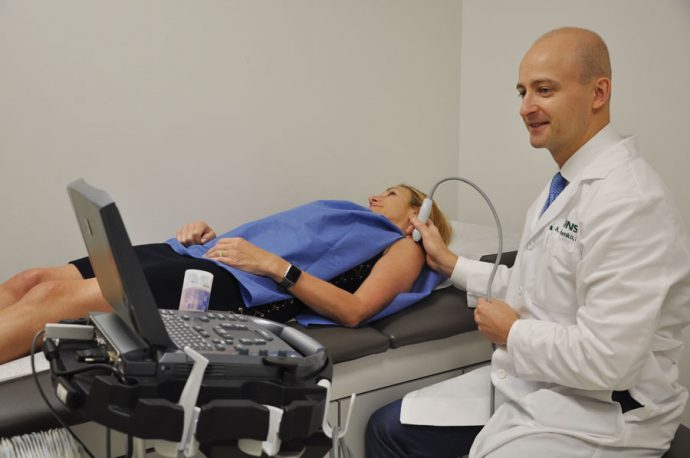When Alex Levchenko comes into an examining room, he is usually wearing a white jacket bearing his name and the acronym “DO.” He admits that he is frequently asked what “DO” is doing on his jacket — it stands for doctor of osteopathic medicine, which often leads to another question: What is the difference between DO and MD?
“There are two branches of medicine,” he explains. “There is the allopathic branch (MD) and the osteopathic branch (DO). Oddly enough, the DO branch was started by an MD in the 1800s. He was getting frustrated that the options he had for treating patients were very limited, and he felt treating the whole patient was better than treating one particular symptom. DO is a more holistic approach. Now, they are pretty much the same. Full-fledged physicians view the patient as a total rather than just isolated symptoms, although a doctor with a DO gets extra training on musculoskeletal issues.”
Levchenko is a board-certified, fellowship-trained physician based at Orthopaedic & Neurosurgery Specialists (ONS), a medical center with offices in Stamford, Greenwich and Harrison. His specialty is the nonoperative treatment of spine, joint and muscle pain, but his approach to this work is framed within a sincerity that cannot be skimmed from a textbook. For example, when asked if he has heard complaints from elderly patients about doctors who treat older patients with unsympathetic attitudes or worse, he glumly acknowledges, “Unfortunately, I have” — and he immediately adds that such behavior is not welcomed at ONS.
“Our practice prides itself on being compassionate,” he says. “We run on time, so patients don’t come and wait for hours. We think compassionate care is the key. We look at you as a human being and not just a part of the body.”
Levchenko’s interest in all things medical took root during his childhood in Soviet Russia. “My parents were teachers,” he recalls. “My mom was teaching high school biology and my dad was teaching music. We had a huge library at home. From the time I was a kid I was always interested in that. By the age of 12, I covered the whole high school curriculum. We were given an assignment at school to write about who we want to be. I decided medicine would be the best route for me. The older I got, I knew that is what I wanted to be.”
In 1994, the 19-year-old Levchenko had the opportunity to pursue medical studies in the U.S. He was grateful to pursue studies away from the political upheaval that followed the collapse of the Soviet system and Boris Yeltsin’s raucous presidency.
“It was an interesting time — a turbulent time in Russia,” he says. “I was lucky to be presented with an opportunity to come here.”
Levchenko attended college at New York University and medical school at New York College of Osteopathic Medicine in Old Westbury. His residency took place in the Physical Medicine and Rehabilitation Department at New York University Langone Medical Center and his fellowship in the Orthopaedic Sports and Spine Rehabilitation Department of Mount Sinai Hospital. At ONS, he averages 100 patients per week, shuttling between the center’s three locations. “My schedule is very interesting and it is never stale,” he says.
One trend that Levchenko is seeing with greater frequency involves injuries affecting middle and high school athletes, which he blames on approaching sports with too much gusto and not enough planning. “A lot of the kids nowadays — and also the parents, everyone so competitive — really push too hard,” he explains. “And by concentrating on one sport, it is easy to get injured early.”
At the other end of the spectrum are patients who are anything but athletic: The desk jockeys who rarely rise above their office workspaces and look away from their computers. When asked if he agreed with the popular comment that “sitting is the new cancer,” Levchenko responds without pause, “100 percent. Our body was not designed for sitting.” He adds that he always provides counsel on how to avoid health issues arising from too much chair time.
“Besides the musculoskeletal problems that sitting can cause, I always tell my patients — lumbar support,” he says. “Lumbar, lumbar, lumbar, support. When you are sitting in a chair, make sure you get one with lumbar support. If it doesn’t have it, put a little pillow in the small of your back. When you are seated, there is pressure on your discs — and if you do it day in and day out, you wind up with some degenerative changes in your back. And one other thing: We are not moving a lot or exercising, so people end up with metabolic diseases like diabetes. All of that comes from inactivity. Not only does it give you back pain and neck pain but all sorts of other problems.”
Off hours, Levchenko still finds himself on call: His 2-and-a-half-year-old daughter enjoys playing patient to her father’s happy diagnoses. However, he wonders whether he would be actively encouraging her to follow in his footsteps.
“Would I want her to go into medicine?” he asks. “You have to like it. If you don’t like it, you’re going to be miserable. The days are long and, after you see the patients, you have to deal with paperwork and phone calls. If you’re unhappy in any field, you get bitter — and bitter and medicine don’t mix.”
For more, visit onsmd.com.


